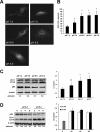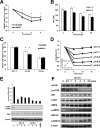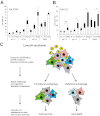Autophagy is a protective mechanism for human melanoma cells under acidic stress
- PMID: 22761435
- PMCID: PMC3436311
- DOI: 10.1074/jbc.M112.339127
Autophagy is a protective mechanism for human melanoma cells under acidic stress
Abstract
Cyclic hypoxia and alterations in oncogenic signaling contribute to switch cancer cell metabolism from oxidative phosphorylation to aerobic glycolysis. A major consequence of up-regulated glycolysis is the increased production of metabolic acids responsible for the presence of acidic areas within solid tumors. Tumor acidosis is an important determinant of tumor progression and tumor pH regulation is being investigated as a therapeutic target. Autophagy is a cellular catabolic pathway leading to lysosomal degradation and recycling of proteins and organelles, currently considered an important survival mechanism in cancer cells under metabolic stress or subjected to chemotherapy. We investigated the response of human melanoma cells cultured in acidic conditions in terms of survival and autophagy regulation. Melanoma cells exposed to acidic culture conditions (7.0 < pH < 6.2) promptly accumulated LC3+ autophagic vesicles. Immunoblot analysis showed a consistent increase of LC3-II in acidic culture conditions as compared with cells at normal pH. Inhibition of lysosomal acidification by bafilomycin A1 further increased LC3-II accumulation, suggesting an active autophagic flux in cells under acidic stress. Acute exposure to acidic stress induced rapid inhibition of the mammalian target of rapamycin signaling pathway detected by decreased phosphorylation of p70S6K and increased phosphorylation of AMP-activated protein kinase, associated with decreased ATP content and reduced glucose and leucine uptake. Inhibition of autophagy by knockdown of the autophagic gene ATG5 consistently reduced melanoma cell survival in low pH conditions. These observations indicate that induction of autophagy may represent an adaptation mechanism for cancer cells exposed to an acidic environment. Our data strengthen the validity of therapeutic strategies targeting tumor pH regulation and autophagy in progressive malignancies.
Figures





References
-
- Cairns R. A., Harris I. S., Mak T. W. (2011) Regulation of cancer cell metabolism. Nat. Rev. Cancer 11, 85–95 - PubMed
-
- Warburg O. (1956) On the origin of cancer cells. Science 123, 309–314 - PubMed
-
- Gatenby R. A., Gillies R. J. (2004) Why do cancers have high aerobic glycolysis? Nat. Rev. Cancer 4, 891–899 - PubMed
-
- Gillies R. J., Robey I., Gatenby R. A. (2008) Causes and consequences of increased glucose metabolism of cancers. J. Nucl. Med. 49, 24S-42S - PubMed
Publication types
MeSH terms
Substances
LinkOut - more resources
Full Text Sources
Other Literature Sources
Medical
Miscellaneous

